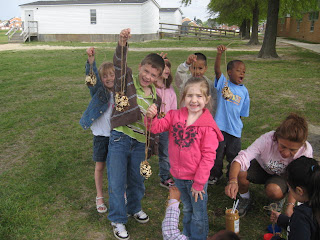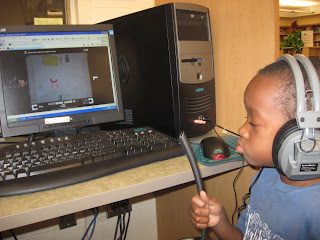



As a conclusion to my final class at Walden University, I completed a course project that consisted of a learning activity that incorporated a multi-user learning environment and a digital game, among many other things. In addition, I had to write a report defending the use of the emerging technology I chose for the learning activity and a grant proposal to obtain funding to implement the technology.
My learning activity for kindergarten consisted of utilizing online and interactive books, a virtual fieldtrip on Second Life, web organizers on Kidspiration, Tag by Leap Frog, and VoiceThreads. The learning activity concluded with having students apply what they learned in the classroom to their community. Students celebrated Earth day and what they learned by problem solving to make their school a better place.
By completing this assignment I have shown that most of what educators do in the classroom should involve exciting and motivating the students we are teaching enough that they want and yearn to learn about this world we are living in. The democratization of knowledge requires that schools include digital content, filtered appropriately, within the school curriculum. The excellent online resources that now make information accessible to anyone that integrating this content into the curriculum is limited only by the teacher’s imagination (Lemke & Coughlin, The Change Agents, 2009). I must say that when I was first beginning my new teaching position in Kindergarten, I wondered how much I could really integrate technology into the classroom, let alone new emerging technologies with such young students. Once I began utilizing what I learned, I found that my students were very open and ready for any technology I threw at them. I found that my students loved using VoiceThread and I was able to influence the teacher across the hall to use it as well, since she happened to walk in while we were using it. I sent out an email to teachers about our Earth day project using VoiceThread and students and teachers from other grades plan on commenting on our class’s VoiceThread and we are entering the project into the technology fair for our district. We are the only Kindergarten class from our school entering a class project into the county’s technology fair. Schools are still using materials developed to teach the students of decades ago, but today’s students are actually very different in the way they think and work. Teaching Kindergarten this online communication offers a way for students to communicate what they are learning through texting or recording their voices. It offers students an opportunity to create for specific audiences and get feedback on their work. Online communication tools would motivate and excite students while preparing them for their lives in the 21st century.
I learned that to properly integrate new technology, it really just requires my teaching the students the proper use of the technology and then modeling and using it consistently. In addition, I learned from this course how to research and then influence others within the school to utilize new technology as well. Yet again, this requires a persistent mode of continually modeling and justifying the need for the technology. For instance, by becoming familiar with MUVEs such as second life, teachers may be able to integrate the use of virtual worlds in the classroom. Second Life is similar to a virtual fieldtrip through the use of an interactive avatar. Students can experience worlds that they may never see otherwise. More and more educators are becoming well-versed in virtual worlds because of their educational implications (Dembo, 2008). Another advantage or reason why gaming should be considered as a possibility in the learning environment should be the ever growing popularity of gaming in our society today. Even the intuitive assumption that a lot of people today play video games doesn’t begin to measure how widespread game playing really is. Half the population of the United States plays video games (DeKanter, 2005). If this is what our students may be enjoying in their free time, why not give them an opportunity to do what they enjoy in school as well and make what they are learning fun?
Many of the issues and problems we face as educators can be reduced with new and emerging technologies. By keeping current with online journals such as The Horizon Report, teachers can find technology that may benefit the students. A smart object can be tied to related information in a variety of media, placing itself within a rich context that is made plain simply by following the connection (Johnson, 2009). As an option for a center during our reading blocks here at our school we are able to use books on tape or CDs as a listening station. At this type of center students wear headphones and listen to a reading of a book and they are supposed to read along with a physical book from the tape to promote their literacy. The problem with this type of center is that it does not help or encourage the child to track the print of the book as it is read and is not very interactive. How could we solve this problem with technology? In the New Horizons 2009 Report I found a new, emerging technology called The Tag by LeapFrog, aimed at very young children. The Tag is a pen-shaped device that allows kids to interact with specially printed books and other materials. Children listen to the story, hear words pronounced, and play games by tapping the pen on the pages (Johnson, 2009). By utilizing this device we are encouraging the students to track the print while it is read as the pen offers the option of reading aloud only if the student places the pen on each word. In addition, this technology uses games to excite the learner about reading. What more could we ask for? Technology is how we will engage and excite learners in the 21st century. Schools like ours need to recognize this, adapt to current student needs and identify new learning models that are engaging to younger generations (Johnson, 2009).
The advent of low-cost global communications has led to mass collaboration in the social, economic, and political sectors (Lemke & Coughlin, The Change Agents, 2009). To increase collaboration among students beyond the walls of the classroom, students need the tools to communicate their thoughts and ideas. From this course I learned how to justify the need for specific technologies and find the funding to purchase them as well. I plan to pursue funding for the technologies in the learning activity through the The Grants Program sponsored by EPA's Environmental Education Division (EED), Office of Children's Health Protection and Environmental Education. Their grants support environmental education projects that enhance the public's awareness, knowledge, and skills to help people make informed decisions that affect environmental quality. EPA awards grants each year based on funding appropriated by Congress. Annual funding for the program ranges between $2 and $3 million. Most grants will be in the $15,000 to $25,000 range.
By obtaining funding through grants to utilize online access to virtual worlds such as Second Life, Tag by LeapFrog, flipcams, digital cams, and microphones we are providing the tools our students will need to survive in a digital age that involves communicating our thoughts and views. By encouraging and utilizing literacy and oral, as well as, digital communication of thought, students will read, role play, learn, create and take action to communicate, promote, and problem solve how we may better protect and enhance our environment. The value of online communication tools goes well beyond social interaction. Access to these tools gives students an opportunity to experience learning in multiple ways, to develop a public voice, to make connections with others around the world, and to compare their own ideas with those of their peers (Johnson, 2009).
Works Cited
DeKanter, N. (2005). Gaming redefines interactivity for learning. TechTrends , 26-32.
Dembo, S. (2008). Virtual Worlds for Educators. District Administration , 48-52.
Johnson, L. L. (2009). The 2009 Horizon Report: K-12 Edition. The New Media Consortium. Austin, Texas.
Lemke, C., & Coughlin, E. (2009). The Change Agents. Educational Leadership , 54-59.



